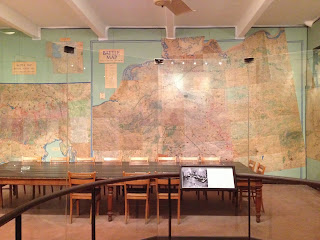 This morning we left Germany after too short a stay and drove through the Alsace to Verdun. Of all the battlefields we have visited this week, this was the most ghostly. It was here that the Germans and the French flung themselves at each other, from the 21st of February to the 18th of December, 1916, the longest battle in history. Two-thirds of a million men fell here in the teeth of machine guns, poison gas, and massed artillery.
This morning we left Germany after too short a stay and drove through the Alsace to Verdun. Of all the battlefields we have visited this week, this was the most ghostly. It was here that the Germans and the French flung themselves at each other, from the 21st of February to the 18th of December, 1916, the longest battle in history. Two-thirds of a million men fell here in the teeth of machine guns, poison gas, and massed artillery.Even as we drove in through the second-growth forest we could see how shells had churned the ground, pitting the landscape in precisely the same way nature wouldn't. At Fort Douaumont the landscape remains mostly as the First World War left it, with concrete walls, foxholes, trenches, and barbed wire. Here was war at its most terrible, and its most senseless. The Germans attacked mostly to get the French to attack them, to bleed them in preparation for yet another offensive. The only thing that stopped the fighting was the need to transfer troops to yet another battle. The war would stretch on for two more years before Europe would fall into an exhausted and dissatisfied peace.
Thousands of French troops are buried in the cemetery here. Thousands of Germans are buried in cemeteries around the periphery. It's easy to see why there is a monument to the dead of the Great War in every town in western Europe. Everyone lost someone, usually someone very close.
In such a battle not everyone who dies is identified. Sometimes the only thing left of a fallen soldier is a bone or two. At the cemetery at Douaumont there is an ossuary, in the shape of a huge sword hilt plunged into the ground, that holds the remains of 60,000 unidentified French and German soldiers. It's easy for us to forget a war that took place so long ago. I won't.
Fortunately for our moods we were in Reims in less than an hour. Notre Dame of Reims is one of the great high Gothic churches of Europe, with its imposing west facade and matching towers. It's built on the site of the church where Clovis, the first Christian king of France, is buried, and is the place where all but two French kings have been crowned. Joan of Arc is a big deal here too, since she captured the place from the English in order to have the Dauphin Charles crowned king.
Reims Cathedral also features a wonderful stained glass by Marc Chagall right at the head of the chancel. I wish we could have taken a better picture, but the technology eludes us. I am posting it here all the same for Jeanne Rundell, who likes Chagall at least as much as I do. So far, in my opinion at least, Chagall is the only Modernist artist whose work doesn't intrude upon the ancient beauty of an older building. He can do my windows (or paint my ceiling) anytime.
After the Cathedral we made our way through the streets of downtown Reims to the Salle de Reddition, a room attached to a local high school where the Germans surrendered to the Allies early in the morning of May 7, 1940. Yes, you World War II enthusiasts, I know when VE day is. That's the day the surrender was announced, not the day it happened. The Russians celebrate it a day later, on May 9, when Stalin made a point of having the Germans sign a special surrender in Berlin.
The museum features the room where the surrender actually took place. It served as the map room for Eisenhower's headquarters, and the table and chairs are in exactly the same position they were in at the time of the signing.
The sun was low on the horizon as we left Reims and headed back to Paris. We got into Charles de Gaulle airport where we left our rental car about 6:30, but a rush-hour cab ride (a fascinating and thrilling adventure) took us an hour more. Vaughn stayed with us until Sunday morning. It was wonderful to have him here. He's such an accomplished guide, and he really can make up the time on the Autoroute. It also didn't hurt to have someone who actually speaks French! It's great to be able to work with your friends.








No comments:
Post a Comment